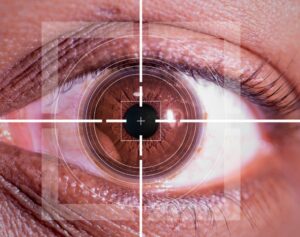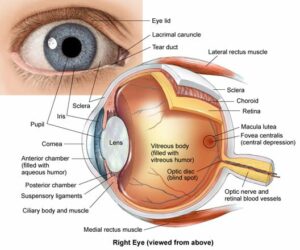If you are considering LASIK surgery, you may be wondering if you are a candidate for the procedure. One condition that can prevent someone from being a good candidate for LASIK is astigmatism. In this blog post, we will discuss what astigmatism is and whether or not it disqualifies you from getting LASIK surgery. We will also provide some tips on how to find the best laser eye surgery center for your needs.
Contents
What Is LASIK?

LASIK is a refractive surgery procedure that helps improve vision without the need for contact lenses or eyeglasses. During the procedure, a laser reshapes the cornea to correct nearsightedness, farsightedness, and astigmatism.
LASIK is a safe, effective way to correct your vision. It has been approved by the FDA for many years and is used by millions of people around the world.
What Is Astigmatism?
Astigmatism is a common vision problem that occurs when the front surface of the eye (the cornea) isn’t perfectly round. This causes light to be refracted differently in different directions, resulting in blurred or distorted vision at all distances. Astigmatism can be mild or severe, depending on how much the cornea differs from its ideal shape.
LASIK for Astigmatism
LASIK for astigmatism is a popular refractive procedure to correct vision and relieve the symptoms of astigmatism. Astigmatism is typically caused by an irregular shape in the cornea, which can cause blurry vision and other vision problems. LASIK for astigmatism involves reshaping the cornea so that it has a more regular shape, resulting in clearer vision and less need for glasses or contact lenses.
The procedure itself is relatively simple and takes only minutes to complete. During the procedure, a laser reshapes the cornea while you are awake but sedated with numbing eye drops. The procedure may also involve using a special type of instrument known as an ocular wavefront analyzer to better map out your optical errors associated with astigmatism.
Before you decide to undergo LASIK for astigmatism, it’s important to understand the risks associated with the procedure.
It’s also important to consider that although the short-term results are usually very good following LASIK surgery, some people may still need glasses or contacts after the procedure.
The Procedure of LASIK for Astigmatism

The procedure of LASIK for astigmatism is similar to the procedure used to treat nearsightedness or farsightedness. To begin, numbing eye drops are put into the eye and a small flap is created in the cornea, which is then folded away. Then, an excimer laser is used to reshape the cornea by removing some of the tissue under the flap.
The doctor will use special software to plan out exactly where and how much tissue needs to be removed from each part of your eye. The procedure usually takes less than 15 minutes per eye and patients may feel mild discomfort during it due to pressure on their eyes.
Afterward, the flap is replaced in its original position and held there with a few stitches. Vision usually improves within the first day, and full recovery can take up to six months.
This procedure of LASIK for astigmatism is successful in correcting nearsightedness, farsightedness, and astigmatism. It can also reduce or eliminate the need for glasses or contacts. However, it is important to note that results may vary depending on the individual case. It is best to consult with an ophthalmologist to discuss if LASIK for astigmatism is right for you.
Patients who have undergone this procedure typically report improved vision and greater satisfaction with their overall quality of life as a result of less dependence on corrective lenses. In some cases, it may even be possible to achieve 20/20 vision after the surgery.
Is Lasik For Astigmatism Effective?
The effectiveness of Lasik surgery for astigmatism depends on the individual. In general, it can be a very effective treatment option for those with mild to moderate levels of astigmatism. Studies show that over 95% of patients who received Lasik surgery experienced significant improvements in their vision. They were able to reduce or eliminate their need for corrective lenses.
However, due to the complexity of astigmatism as an eye condition, not every patient will experience perfect results from Lasik surgery. Some individuals may still require glasses or contacts even after receiving the procedure. This is particularly if they have higher levels of astigmatism or another underlying issue causing blurred vision.
Also, the effectiveness of Lasik surgery for astigmatism can be impacted by other factors. These are such as the amount of time since diagnosis and age. In general, the earlier an individual is diagnosed with astigmatism, the more likely they are to experience successful results from Lasik surgery.
What Are the Potential Complications of LASIK Surgery for Astigmatism?
As with any medical procedure, there is always some risk involved in LASIK surgery for astigmatism. The most common risks include dry eyes, discomfort or irritation during or shortly after surgery, and difficulty seeing clearly at night or in low-light conditions.
In rare cases, patients may experience vision loss due to complications from the procedure itself. This is why it’s important to consult with a qualified eye doctor before undergoing the procedure. The doctor should review your medical history and conduct a thorough eye exam to ensure that you are a good candidate for LASIK surgery for astigmatism.
Some of the complications of the LASIK procedure are less serious. These include halos around lights, double vision, and starbursts or glare when looking at bright objects. In most cases, these symptoms will go away over time with proper treatment.
It is also important to be aware of the risk of infection following any type of surgery, including LASIK for astigmatism. Most surgeons recommend taking antibiotics before and after the procedure to reduce the risk of infection. Additionally, you must follow your eye doctor’s instructions regarding post-operative care during recovery.
Are There Any Alternatives to LASIK Surgery for Astigmatism?

The alternatives of LASIK surgery for astigmatism include implantable contact lenses, refractive lens exchange, corneal rings, and excimer laser surface ablation. Implantable contact lenses are artificial intraocular lenses that are surgically inserted inside the eye to correct nearsightedness and astigmatism. Refractive lens exchange is a procedure in which the natural crystalline lens of the eye is removed and replaced with an artificial one to correct vision issues. These are such as astigmatism.
Corneal rings also known as intracorneal ring segments (ICRS) are tiny plastic arcs that can be implanted into the cornea to reshape it after being surgically cut out by a laser. Excimer laser surface ablation uses ultraviolet light on the outer surface of the cornea to reshape and correct vision issues.
Other vision correction methods that don’t involve surgery include eyeglasses, contact lenses, and ortho-k contacts. Eyeglasses are a very common solution for people with astigmatism since they can easily be customized to fit each individual’s specific needs. Contact lenses provide an alternative solution to eyeglasses but may require more care and upkeep than glasses do. Ortho-k contacts also known as overnight vision correction is a method in which special contact lenses are worn at night. This is while sleeping to correct vision during the day without having to wear glasses or contacts.
Ultimately, it will be up to you and your doctor to decide what the best option is for correcting your astigmatism according to your lifestyle and preferences. Make sure you discuss all of your options with your doctor so that you can make an informed decision.
Conclusion
LASIK for astigmatism is an effective way to correct vision. It can provide long-term stability, reduce the need for glasses or contacts and improve your overall quality of life. The best way to determine if LASIK for astigmatism is right for you is to talk with a qualified eye doctor about your situation. All procedures carry some risk, so be sure to weigh the pros and cons carefully before making a decision. With the help of experienced personnel and state-of-the-art technology, LASIK surgery can be a safe and rewarding experience that can help you see better than ever before!
Lasik surgery is a safe 10-minute procedure to help you get rid of glasses. MantraCare offers the most advanced LASIK options. If you have any questions on LASIK surgery feel free to reach out to us at +91-9711116605
